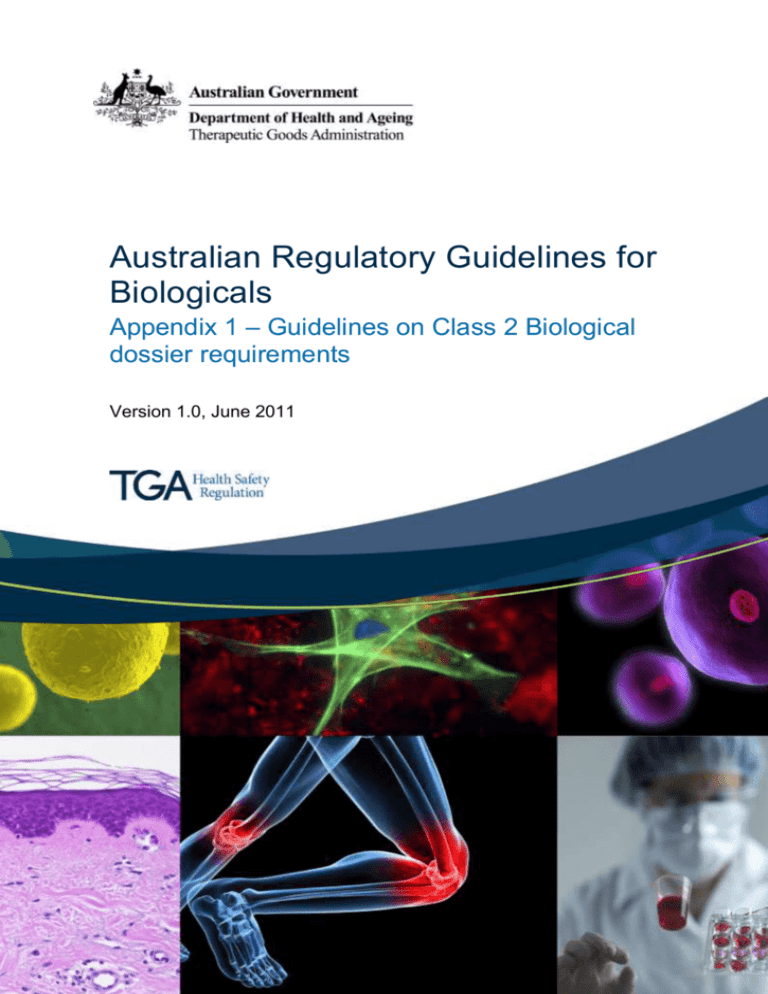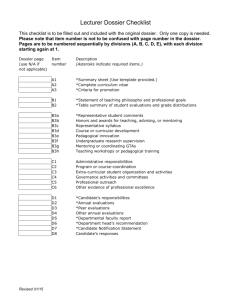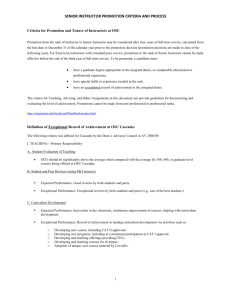4.1 Biological starting material - Therapeutic Goods Administration
advertisement

Australian Regulatory Guidelines for Biologicals Appendix 1 – Guidelines on Class 2 Biological dossier requirements Version 1.0, June 2011 Therapeutic Goods Administration About the Therapeutic Goods Administration (TGA) The TGA is a division of the Australian Government Department of Health and Ageing, and is responsible for regulating biologicals, medicines and medical devices. TGA administers the Therapeutic Goods Act 1989 (the Act), applying a risk management approach designed to ensure therapeutic goods supplied in Australia meet acceptable standards of quality, safety and efficacy (performance), when necessary. The work of the TGA is based on applying scientific and clinical expertise to decision-making, to ensure that the benefits to consumers outweigh any risks associated with the use of biologicals, medicines and medical devices. The TGA relies on the public, healthcare professionals and industry to report problems with biologicals, medicines or medical devices. TGA investigates reports received by it to determine any necessary regulatory action. To report a problem with a biological, medicine or medical device, please see the information on the TGA website. Copyright © Commonwealth of Australia 2011 This work is copyright. Apart from any use as permitted under the Copyright Act 1968, no part may be reproduced by any process without prior written permission from the Commonwealth. Requests and inquiries concerning reproduction and rights should be addressed to the Commonwealth Copyright Administration, Attorney General’s Department, National Circuit, Barton ACT 2600 or posted at http://www.ag.gov.au/cca Australian Regulatory Guidelines for Biologicals Appendix 1 – Guidelines on Class 2 Biological dossier requirements, V1.0 June 2011 Page i Version history Version Description of change Author Effective date V1.0 Original BSS June 2011 Australian Regulatory Guidelines for Biologicals Appendix 1 – Guidelines on Class 2 Biological dossier requirements V1.0 June 2011 Page 3 of 24 Contents INTRODUCTION 6 GENERAL REQUIREMENTS 7 Text Requirements __________________________________________________________ 7 Page layout and Printing ___________________________________________________ 7 Dossier submission __________________________________________________________ 8 Dossier structure ____________________________________________________________ 9 TECHNICAL REQUIREMENTS 11 1. INTRODUCTION _________________________________________________________ 11 1.1 Table of Contents ______________________________________________________ 11 1.2 Submission form_______________________________________________________ 11 1.3 Biological lodgement _________________________________________________ 11 2 SCOPE _____________________________________________________________________ 12 3. RISK MANAGEMENT ____________________________________________________ 13 4. QUALITY AND MANUFACTURING ASPECTS__________________________ 14 4.1 Biological starting material __________________________________________ 14 4.1.1 Donor selection (Medical and Social history) __________________________________ 14 4.1.2 Donor blood sampling & testing ________________________________________________ 14 4.1.3 Donor evaluation and management ____________________________________________ 14 4.1.4 Collection of Starting Material __________________________________________________ 15 4.2 Manufacturing process _______________________________________________ 16 4.2.1 Manufacturer’s details ___________________________________________________________ 16 4.2.2 Description of manufacturing process and process controls _________________ 16 4.2.3 Control of critical material ______________________________________________________ 16 4.2.4 Critical steps and intermediates ________________________________________________ 17 4.2.5 Validation of the manufacturing process _______________________________________ 17 4.3 Characterisation _______________________________________________________ 17 4.4 Control of finished product __________________________________________ 18 4.4.1 Release specifications ___________________________________________________________ 18 4.4.2 Analytical procedures ___________________________________________________________ 18 4.4.3 Validation of analytical methods ________________________________________________ 18 Australian Regulatory Guidelines for Biologicals Appendix 1 – Guidelines on Class 2 Biological dossier requirements V1.0 June 2011 Page 4 of 24 4.4.4 Finished product analysis _______________________________________________________ 18 4.4.5 Justification of specifications ____________________________________________________ 19 4.4.6 Containers ________________________________________________________________________ 19 4.5 Storage and stability __________________________________________________ 19 4.6 Labelling and release documentation ______________________________ 19 4.7 Transportation ________________________________________________________ 20 5. INTENDED USE __________________________________________________________ 21 6. APPENDICES _____________________________________________________________ 22 Appendix 1 Summaries of compliance with standards ______________________________ 22 Appendix 2 References ________________________________________________________________ 22 Appendix 3 Supplementary dossier information (where applicable) ______________ 22 Appendix 4 Overseas regulatory information (where applicable) __________________ 22 7. REFERENCES _____________________________________________________________ 23 Australian Regulatory Guidelines for Biologicals Appendix 1 – Guidelines on Class 2 Biological dossier requirements V1.0 June 2011 Page 5 of 24 INTRODUCTION This part of the guidance document outlines the format and contents of a dossier that is to be submitted in support of an application for a biological therapeutic good. The general format of the submitted dossier is outlined in the class-specific guidelines under ‘General requirements’. It is suggested that the dossier be divided into clearly identified sections covering the scope of the application, risk management, quality and manufacturing aspects. In other parts of the guidance covering the labelling, infectious disease and product-specific orders, tables are provided to guide the Sponsor to where individual clauses should be discussed within the dossier. Under each heading information is provided to assist the Sponsor as to the content that should be included. The suggested content identifies key aspects that should generally apply to any biological application, but it is recognised that due to the diversity of potential biologicals, all of the sections/points may not apply to a specific application. Where possible, references are made to national and international reference and guidance documents that can be used to assist the Sponsor with specific aspects of the application. Importantly, these statements are not intended to introduce any additional requirements above the applicable Standards, rather they articulate mechanisms for compliance. It should be noted that in the guidelines the headings and contents throughout Parts 1-4 are broadly applicable across Classes 2, 3 and 4, as are the non-clinical and clinical development parts (Parts 5-6) for Class 3 & 4 biologicals. If there are any questions, or if clarification is required in relation to this guidance on the dossier requirements for a biological, please contact the TGA, Biological Sciences Section either by phone, email or in writing, as detailed on our website. It is also recommended to meet directly with the TGA in a pre-submission process to facilitate the compiling and subsequent submission of the dossier. The information contained within the dossier must demonstrate compliance with all relevant product-specific and default standards (if applicable). It should also more broadly address all headings listed in the dossier structure. If a particular section/point of the dossier does not apply to the biological in question, this should be stated and a justification given. To assist applicants to systematically address the requirements outlined in TGO 87 (General requirements for the labelling of biologicals) and product-specific orders, tables are provided within their guidance documents that indicate where individual clauses should be documented in the main dossier. It is suggested that the recommendations for donor selection, testing and minimising infectious disease detailed in ARGB Appendix 4 are considered when completing this dossier. Please contact the TGA if any clarification is required. The technical requirements stated for the dossier should be strictly adhered to. Australian Regulatory Guidelines for Biologicals Appendix 1 – Guidelines on Class 2 Biological dossier requirements V1.0 June 2011 Page 6 of 24 GENERAL REQUIREMENTS Text Requirements The dossier must be written in English Where supporting material is not originally in English, a copy in the original language and a full translation must be submitted, the accuracy of which is the responsibility of the sponsor Font sizes for text and tables must be of a style that are large enough to be easily legible, even after photocopying or when provided electronically Generally, a font size of 10 points is considered acceptable in tables, but fonts smaller than 12 points should be avoided whenever possible Times New Roman, 12 point font is recommended for narrative text Times New Roman, 10 point font is recommended for footnotes Page layout and Printing Printed copies should be printed on A4 paper and bound. The dossier MUST be formatted according to the headings listed under Dossier Structure Sequential page number, month/year and manufacturer name should be included in the footer to every page in the dossier Appendices should be set out in a legible format, footnoted with appendix number, continuation of sequential page numbering (following on from the main dossier page numbers), month/year and manufacturer name Text, tables and figures must be prepared using margins that allow the documents to be printed on A4 paper The left-hand margin must be sufficiently large that information is not obscured through binding Documents can be double-sided provided that legibility is not impaired, margin space is sufficient and page numbers are applied to both sides A table of contents, including any attachments, should be provided Australian Regulatory Guidelines for Biologicals Appendix 1 – Guidelines on Class 2 Biological dossier requirements V1.0 June 2011 Page 7 of 24 Dossier submission A table of contents, including indexing, must be included. The dossier MUST be formatted according to the headings listed under Dossier Structure THREE printed and bound copies of the dossier, with all appendices, must be supplied to the TGA Dossiers should be sent to: Therapeutic Goods Administration Department of Health and Ageing PO BOX 100 MDP122 WODEN ACT 2606 or delivered by courier to: Therapeutic Goods Administration 136 Narrabundah Lane SYMONSTON ACT 2609 A CD/DVD containing an electronic version of the dossier should be supplied with the dossier (USB keys, hard drives etc are not acceptable). Any scanned components should be inserted into the Microsoft Word version as JPEG files, or provided in PDF format. Sponsors must provide the electronic submission dossier on the smallest number of media units possible, taking into consideration the size of the submission. If more than one unit is needed, avoid spanning the content of a part or a Section of the dossier over two units. PDF files produced from an electronic source document are highly preferred over PDF files produced from scanned paper, since those 'electronic' PDF files provide the maximum functionality to the reviewers in terms of search and print capabilities, and copy and paste functionality. Ideally, a note should be provided confirming that either the data on the electronic submission dossier supplied is identical to that in the hard copy dossier or, if not identical, a declaration that the dossiers are identical with the exception of the specified differences Australian Regulatory Guidelines for Biologicals Appendix 1 – Guidelines on Class 2 Biological dossier requirements V1.0 June 2011 Page 8 of 24 Dossier structure The following headings form the structure by which the dossier should be compiled: 1 INTRODUCTION 1.1 Table of contents 1.2 Submission form 1.3 Biological lodgement 2 SCOPE 3 RISK MANAGEMENT 4 QUALITY AND MANUFACTURING ASPECTS 4.1 Biological starting materials 4.1.1 Donor selection 4.1.2 Donor blood sampling and testing 4.1.3 Donor assessment and management 4.1.4 Collection of starting material 4.2 Manufacturing process 4.2.1 Manufacturer’s details 4.2.2 Description of manufacturing process and process controls 4.2.3 Control of material and equipment 4.2.4 Critical steps and intermediates 4.2.5 Validation of the manufacturing process 4.3 Characterisation 4.4 Control of final product 4.4.1 Release specifications 4.4.2 Analytical procedures 4.4.3 Validation of analytical methods 4.4.4 Finished product analysis 4.4.5 Justification of specifications 4.4.6 Containers 4.5 Storage and Stability 4.6 Labelling and release documentation 4.7 Transportation 5 INTENDED USE 6 APPENDICES Appendix 1 Summaries of compliance with standards Appendix 2 References Australian Regulatory Guidelines for Biologicals Appendix 1 – Guidelines on Class 2 Biological dossier requirements V1.0 June 2011 Page 9 of 24 Appendix 3 Supplementary dossier information Appendix 4 Overseas regulatory information (if applicable) Australian Regulatory Guidelines for Biologicals Appendix 1 – Guidelines on Class 2 Biological dossier requirements V1.0 June 2011 Page 10 of 24 TECHNICAL REQUIREMENTS 1. INTRODUCTION The section contains general information relating to the submission. 1.1 Table of Contents The TOC must be formatted according to the headings listed under Dossier Structure and contain sufficient additional information to allow quick location of any reports contained within the sections; such as risk analysis documents, standard operating procedures and validation reports. 1.2 Submission form At the completion of biological application, a copy of the eBS ‘Submission Document for a Biological Application’ must be printed and placed in the dossier. 1.3 Biological lodgement At completion of biological application through eBS, a copy of the full ‘Biological Lodgement’ must be printed and placed in the dossier. Australian Regulatory Guidelines for Biologicals Appendix 1 – Guidelines on Class 2 Biological dossier requirements V1.0 June 2011 Page 11 of 24 2 SCOPE a) The scope of this application should detail the class 2 product type, including the individual biologicals to be captured b) This section is an introduction to the product type, including general background information and a summary of the complete dossier. This should be written for a general scientific audience. The introduction should address: A brief description of the product type and grouped products (when applicable). References should be listed A brief but current and relevant literature review A summary of the manufacturing process Australian Regulatory Guidelines for Biologicals Appendix 1 – Guidelines on Class 2 Biological dossier requirements V1.0 June 2011 Page 12 of 24 3. RISK MANAGEMENT The adoption of a risk management system that applies through all stages of the product’s life, from concept and tissue selection/collection to release and intended use, is essential for ensuring optimum product quality and safety. The risk management methodology should assist the manufacturer to identify, analyse, evaluate and control the risks in all phases of a products’ lifecycle. ARGB Appendix 11 ‘Risk management’ systematically outlines the approach that should be taken to risk management as applicable to biologicals, including a list of references that may be used to guide the development and maintenance of a risk management framework. In addition, the annexes work through clear examples of how risk identification, analysis and management can be performed and documented. Risk management documentation should be provided for all Class 2 biological products to demonstrate that the principles of risk management have been satisfactorily addressed. Annex 2 of Appendix 11 ‘Risk management’ provides detailed examples on how risk analysis process could be applied to a class 2 biological; and Annex 3 provides an example of how the entire risk analysis and risk management process could be documented. Australian Regulatory Guidelines for Biologicals Appendix 1 – Guidelines on Class 2 Biological dossier requirements V1.0 June 2011 Page 13 of 24 4. QUALITY AND MANUFACTURING ASPECTS 4.1 Biological starting material The information supplied should clearly describe all aspects of the collection of the biological starting materials, highlighting compliance with relevant standards when applicable. Consideration of final product quality, efficacy and safety, and hence recipient safety, is of utmost importance when planning and carrying out the collection of the starting material. Copies of all associated documents, such as donor selection criteria and donor information forms should be supplied. 4.1.1 Donor selection (Medical and Social history) There should be written criteria for donor selection, and a documented procedure for the interview process These documents must capture the medical and social history of prospective donors If a Third party donor selection criteria is utilised, it should be clearly stated how the contracting organisation will be kept up to date with changes to the selection criteria 4.1.2 Donor blood sampling & testing There must be written procedures for the collection, storage (archiving) and re-testing of donor blood samples Procedures relating to donor blood testing must be documented The test kits/methodologies used in the evaluation of donor samples must be recorded in written procedures and/or in the service agreement with contracted testing laboratory Where required, any additional information necessary for interpretation of individual infectious disease testing results, must be documented. For example, HBV testing algorithms to interpret e.g. NAT positive/serology negative or NAT negative/serology positive results A list of all sites that perform infectious disease testing and storage of archived blood samples must be provided as these are considered manufacturing steps. If a contract laboratory is used a copy of the service agreement should be provided. Renewal of these contracts will be assessed as part of audits, but entering a contract with a new provider represents a variation to the manufacturing process and TGA must be notified. 4.1.3 Donor evaluation and management The donor selection documentation and testing results must be reviewed and evaluated to determine suitability of the donor The criteria and procedure for determination of donor suitability and for donor management should be documented. For donor management, areas to be covered should include, but not be limited to: – temporary deferral, e.g. a donor suspected to be infected with HIV should be deferred until an uninfected state can be determined – permanent deferral, e.g. a donor known to be infected with HIV – acceptance criteria – re-admission criteria post-deferral, if applicable e.g. the timeframe following a temporary deferral beyond which a donation would be accepted, or specific blood tests that would be carried out to confirm the absence of an infectious disease agent post-infection Australian Regulatory Guidelines for Biologicals Appendix 1 – Guidelines on Class 2 Biological dossier requirements V1.0 June 2011 Page 14 of 24 – criteria for acceptance with limited product release, e.g. collection for autologous release only when a donor tests positive for an infectious disease agent 4.1.4 Collection of Starting Material The procedures for collection of the biological starting material from the donor should be provided in the dossier, and be based on the principles of risk management Areas to be covered should include, but not be limited to: – – – – – – – – – Physical assessment prior to donation – refer to ARGB Appendix 4 Quantity of donation e.g. maximum collection volume or size/mass Collection intervals, where applicable Collection packs/containers/kits (see information box, below) List of all critical materials used in collection process, with appropriate quality and safety specifications Bioburden sampling, where applicable Post-asystole collection times, when appropriate Any donor treatment required to facilitate or augment the donation process, for example the treatment with factors to mobilise specific progenitor cells Details on labelling should be included in Section 4.6 of the dossier Validation of the biological starting material collection process should be included, to demonstrate starting material quality If no manufacturing/processing occurs prior to storage, the storage and stability of the biological should still be discussed in Section 4.5 of the dossier Any transport of the biological starting material from the collection site should be documented in Section 4.7 of the dossier; including transport of material to a storage facility Where the starting material collection pack/kit assembled by the manufacturer is only for use in relation to that manufacturer, whether in a surgical or mortuary environment, and are not supplied outside the manufacturer's governance, they are not required to be included on the ARTG. The manufacturer's obligation, however, in respect of the cGMP means that product(s) used in collection and manufacture of the therapeutic good should be of a quality demonstrably adequate for the purpose for which it is to be used and should not compromise the quality or safety of the finished therapeutic good. Full details of the pack/kit contents, item specifications and use, demonstrating that quality and safety of the material being collected and handled are not being compromised, should be included in the submitted dossier. Kits/packs that are supplied outside its manufacturer's governance and used in the treatment of a patient are generally regulated as medical devices, except where the kit or pack is regulated as a medicine (consists of medicines), or the kit does not contain goods regulated by the Therapeutic Goods Act. Even if the pack/kit is not required to be on the ARTG, it is highly recommended that those items contacting the human tissue or donor samples for testing are approved for human use, that is, they are included on the ARTG or are of pharmacopoeial grade. Australian Regulatory Guidelines for Biologicals Appendix 1 – Guidelines on Class 2 Biological dossier requirements V1.0 June 2011 Page 15 of 24 4.2 Manufacturing process The section should clearly describe all aspects of the manufacturing process from the transport of the starting material to the manufacturing site to the final product release, highlighting compliance with relevant standards when applicable. The process should be carefully designed to ensure product consistency and a risk management approach should be used to inform the in-process controls and specifications. Note that for a Class 2 biological only “minimal manipulation” is permitted. Minimal manipulation is defined in the Therapeutic Goods Regulations 1990 Part 1 Section 2. If it is unclear if your product is processed by minimal manipulation please contact the TGA for clarification, prior to submission of an application. 4.2.1 Manufacturer’s details Name, address, process steps and TGA GMP licence/certification information should be provided for all manufacturers. At minimum, all manufacturers must have a current GMP licence (under Part 3-3 of the Act) or certificate/clearance (under Part 3-2A of the Act), or provide evidence of an application for a licence to manufacture therapeutic goods in Australia or an application for a GMP certificate for the overseas manufacturers submitted to the Office of Manufacturing Quality. Ideally the information should be presented in a tabulated form and copies of the licence/certificate/application should be included in the dossier. Manufacturers involved solely in collection of biological starting material or infectious disease testing relating to donor evaluation should be listed in Section 4.1.4 and 4.1.2, respectively. 4.2.2 Description of manufacturing process and process controls Description of entire manufacturing process, from the completion of the collection of the biological starting material to final product release. This should include an annotated flow diagram, with indication of the critical steps and in process control points. For example, transport of starting material to the manufacturer, cryopreservation, labelling and storage A statement that the manufacturing process comprises processes considered ‘minimal manipulation’, if applicable Detail microbial control steps 4.2.3 Control of critical material A list of all critical materials (as defined in ARGB Appendix 14 – Glossary), including excipients, and medical devices used in the manufacturing process. This list should include, but not be limited to: – – – – – – Name of material Source (company) of material The role of the material in the manufacturing process Quantity used in the manufacturing process (when applicable) If material is registered on ARTG or not If the material complies with a defined Standard (e.g. Pharmacopoeial monograph) or inhouse specifications Where the product is not on the Register or a default Standard does not apply, information must be provided in order to characterise the critical material and to demonstrate control of the quality and safety of the material. The level of control of each material should reflect its use and potential risk to the product. More detail on minimal information required on such materials is discussed in ARGB Appendix 4. Australian Regulatory Guidelines for Biologicals Appendix 1 – Guidelines on Class 2 Biological dossier requirements V1.0 June 2011 Page 16 of 24 There is provision under the Therapeutic Goods Regulations, Regulation 16 GF for data (e.g. about a critical material) to be submitted directly to the TGA for evaluation, for example where information is in-confidence to the material manufacturer. The minimal requirements for critical material that are solutions, antimicrobial agents, or material containing any components of human or animal origin are discussed in ARGB Appendix 4. 4.2.4 Critical steps and intermediates A full description, including acceptance criteria, of all critical control points (in-process controls) and key elements as informed by risk analysis should be included. For example, determination of heart valve tissue competency prior to freezing Quarantine measures for biological starting material and donor blood/plasma samples until donor testing is complete, or for autologous material found to be infectious disease positive should be discussed Detail microbial control measures – – – – Bioburden sampling points (pre- and post-processing sampling) Appropriate bioburden specifications at each stage Bioburden reduction strategies, if applicable Where appropriate, a list of microorganisms tested should be provided, including specified and ‘allowed’/acceptable microorganisms (if positive growth is identified) 4.2.5 Validation of the manufacturing process Each step in the manufacturing process should be validated. If further information is required, guidance on possible methodologies that could be utilised can be found in ICH Q2R1 “Validation of Analytical Procedures: Text and Methodology” Validation of microbiological methods is described in the default pharmacopoeial (BP, Ph.Eur, USP) standards and in the following ISO standards ISO 11737-1 Sterilization of medical devices – Microbiological methods – Part 1: Determination of a population of microorganisms on products. ISO 14160 Sterilization of health care products –Liquid chemical sterilizing agents for single-use medical devices utilizing animal tissues and their derivatives – Requirements for characterization, development, validation and routine control of a sterilization process for medical devices. In case of limited sample availability, and where justified, more extensive validation should be performed using samples with comparable characteristics 4.3 Characterisation Broad characterisation of the biological during product development can facilitate identification of critical quality attributes and provide crucial reference points for determining the effect of a variation to the manufacturing process on the biological. Where characterisation studies are performed on the product at any stage of the manufacturing process, beyond those routinely performed as part of in-process testing or as release criteria, they should be documented here. Generally for Class 2 biologicals such additional studies would not be performed. An example of where such studies may be performed could be the characterisation by microarray of the gene expression profile of cultured cells at various stages of expansion. In-process controls and specifications would not capture all the details. The additional studies do however provide Australian Regulatory Guidelines for Biologicals Appendix 1 – Guidelines on Class 2 Biological dossier requirements V1.0 June 2011 Page 17 of 24 confidence to both the manufacturer and regulator that the process is satisfactorily controlled. In addition, such studies can be crucial if changes are introduced to the cell culture process. 4.4 Control of finished product The specifications of the finished product must be fully determined and controlled if the quality is to be ensured. A risk analysis and management strategy should be used inform the final product specifications, in conjunction with characterisation studies and relevant Standards. 4.4.1 Release specifications Finished product release specifications should include, but not be limited to: – – – – – – Key parameters identified as crucial to product quality Specifications identified in default standards and/or Orders Completed infectious disease screening Microbial control and/or Sterility Processing times met, where applicable Examination and evaluation of cells or tissue prior to release, where appropriate 4.4.2 Analytical procedures All analytical procedures should be listed and copies attached Details of all reference standards and material should be provided – primary reference material should be established for all critical assays used in the testing of finished product – where a national or international standard is available, appropriate reference material should be calibrated against it – where appropriate, a description of the preparation of the reference material and documentation of its characterisation and storage conditions should be provided 4.4.3 Validation of analytical methods All analytical procedures should be validated. If further information is required, guidance on possible methodologies that could be utilised can be found in ICH Q2R1 “Validation of Analytical Procedures: Text and Methodology” Validation of microbiological methods is described in the default pharmacopoeial (BP, Ph.Eur, USP) standards and in the following ISO standards ISO 11737-1 Sterilization of medical devices – Microbiological methods – Part 1: Determination of a population of microorganisms on products. ISO 14160 Sterilization of health care products –Liquid chemical sterilizing agents for single-use medical devices utilizing animal tissues and their derivatives – Requirements for characterization, development, validation and routine control of a sterilization process for medical devices. 4.4.4 Finished product analysis The ability of the manufacturing process to consistently produce final product within the stated specifications, must be demonstrated The number of manufacturing runs analysed to demonstrate process consistency should be stated and justified Australian Regulatory Guidelines for Biologicals Appendix 1 – Guidelines on Class 2 Biological dossier requirements V1.0 June 2011 Page 18 of 24 4.4.5 Justification of specifications The release specifications should be justified. For example, with respect to the relevant Standards, and/or published literature, and/or based on process validation 4.4.6 Containers The suitability of the container/s used for the final product must be demonstrated; including information and validation of container type, container and closure material or, where applicable showing compliance to relevant Standards 4.5 Storage and stability Biological materials are particularly sensitive to adverse conditions, and as such an investigation of the stability of the final product, should be carried out, and used to set storage conditions and justify the proposed shelf-life. The storage conditions and shelf-life of the biological should comply with the product-specific standard, or should be justified based on either submitted data and/or literature If stability studies have been performed, a summary of the studies and conclusions should be provided In case of limited sample availability, and where justified, more extensive stability studies could be performed with samples of comparable characteristics 4.6 Labelling and release documentation The traceability of the biological material throughout the lifecycle of a biological, from initial donor selection to administration of the biological finished product to the recipient is a critical component of product labelling and documentation. This is achieved by the establishment of a single rational labelling system that allows all users involved in the collection, manufacturing and administration of the biological to utilise. In addition, the information captured in the final product labels and accompanying release documentation is critical to informing the end user and recipient of the quality, safety and efficacy of the biological. Compliance with TGO 87 must be demonstrated Examples of all unfilled labels, and any accompanying documentation, demonstrating compliance with TGO 87 , must be supplied Examples should be provided to scale and in colour, where applicable The labels must demonstrate traceability of biological material from initial donor and throughout the manufacturing process TGO 87 outlines the minimal requirements for the container labels and accompanying documentation, but the use/inclusion of release documentation detailing additional product information, e.g. results of release testing, are encouraged. Copies of these accompanying documents should be provided Where bioburden testing identified growth of ‘allowed’/acceptable organisms the release labels and accompanying documents should contain this information, where allowed in a specific TGO Where infectious disease testing is positive, the release labels should contain this information, and will only be acceptable if the label states ‘for autologous use only’ Outer container labels and transport labels should be detailed under Section 4.7 Transportation Australian Regulatory Guidelines for Biologicals Appendix 1 – Guidelines on Class 2 Biological dossier requirements V1.0 June 2011 Page 19 of 24 When required by a product specific standard, evidence of microbial contamination of a released product must be supplied to persons detailed in the product specific standard 4.7 Transportation This section covers any transportation of the biological during any stage of the manufacturing process, from the collection of the starting material to the release of the final product. Packaging, labelling and temperature for transportation should comply with product-specific Standards, local laws and regulations, and be fully validated. Transportation of the biological at any stage of its manufacturer must be detailed; including transportation of the starting material from the collection site to the manufacturing site, and any transportation between manufacturing sites Transportation and packing procedures (including labelling) should be provided and fully validated with respect to temperature and integrity Australian Regulatory Guidelines for Biologicals Appendix 1 – Guidelines on Class 2 Biological dossier requirements V1.0 June 2011 Page 20 of 24 5. INTENDED USE The dossier must justify the efficacy of a Class 2 biological. For Class 2 biologicals the term 'intended use' is used to address the efficacy of the product for the clinical purpose for which it will be supplied. The concept behind intended use is that it reflects the broad clinical use of the product, and is not required to be supported by product specific clinical data. In contrast, the more commonly used pharmaceutical concept of 'indication' is usually related to a specific product and disease/patient group. Indications are usually required to be supported by product specific clinical data. A statement supporting the intended use should be included in the dossier. This should be a brief summary of evidence which supports the intended clinical use. This evidence could be drawn from the scientific literature, including appropriate reviews or reference to standard texts, and/or clinical usage guidelines. The summary should include discussion on the relevance of the supporting evidence to the actual biological product and route of administration being proposed in the application. The evidence presented may include (or reference) clinical data but this is not required. Where a Class 2 dossier contains a number of products the evidence provided should support all the products. The intended use is chosen from a drop down menu in the biologicals application form. If a suitable intended clinical use is not included in the drop down menu the TGA should be contacted and additional intended clinical use 'phrases' can be added, if appropriate. Guidance for monitoring and surveillance requirements still to be informed. Australian Regulatory Guidelines for Biologicals Appendix 1 – Guidelines on Class 2 Biological dossier requirements V1.0 June 2011 Page 21 of 24 6. APPENDICES Appendix 1 Summaries of compliance with standards For TGO 87 and the relevant product-specific TGOs, tables are provided within their guidance documents that indicate where individual clauses should be documented in the main dossier. In addition, these tables contain a column where a summary of the information included in the dossier to address that individual clause must be provided. These tables should be completed, printed and placed in this Appendix. Appendix 2 References Copies of all papers used as supporting evidence or/and to justify any specifications must be provided. All other references should only be listed. Appendix 3 Supplementary dossier information (where applicable) (a) Does this application depend upon the outcome of, or relate to, any other application currently under evaluation by TGA? If YES, please provide submission number(s) and/or TGA numbers (b) Does the submission make reference to ‘in confidence’ data submitted by manufacturers directly to the TGA for evaluation; such as a information on the manufacture of a critical material, a Drug Master File (DMF), a Plasma Master File (PMF), a Biological Master File (BMF) or to an EDQM Certificate of Suitability (CEP)? If so, the applicant must provide in writing permission from the owner of the confidential information allowing the TGA to access that information on behalf of the applicant. (c) If there were any pre-submission meetings, please detail agenda, conclusions and contact person and attach any pertinent emails, minutes from meetings, letters etc. (d) Is there any other pertinent information that would assist the TGA with the evaluation of the dossier, for example planned changes to the contact person or planned changes to company details. Appendix 4 Overseas regulatory information (where applicable) (a) Please detail the commercial history, including date of first clinical application of the product and the marketing in each country other than Australia. (b) Please detail the regulatory status in each country other than Australia, including approvals, rejections, severe adverse reactions linked to the product and recalls. (c) Is there one or more overseas manufacturer of the goods for which GMP clearance letters from the TGA have not yet been obtained or requested? (to establish that the overseas manufacturers of the goods are of an acceptable standard Australian Regulatory Guidelines for Biologicals Appendix 1 – Guidelines on Class 2 Biological dossier requirements V1.0 June 2011 Page 22 of 24 7. REFERENCES The following is a list of URLs referenced in this guidance document. Resource URL TGA website http://www.tga.gov.au TGA blood and tissues website http://www.tga.gov.au/industry/btb.htm ICH Q2R1 “Validation of Analytical Procedures: Text and Methodology” http://www.ich.org/fileadmin/Public_Web_Site/ICH _Products/Guidelines/Quality/Q2_R1/Step4/Q2_R1_ _Guideline.pdf ISO (International Organisation for Standardization) http://www.iso.org/iso/home.html Australian Regulatory Guidelines for Biologicals Appendix 1 – Guidelines on Class 2 Biological dossier requirements V1.0 June 2011 Page 23 of 24 Therapeutic Goods Administration PO Box 100 Woden ACT 2606 Australia Email: info@tga.gov.au Phone: 1800 020 653 Fax: 02 6232 8605 www.tga.gov.au







